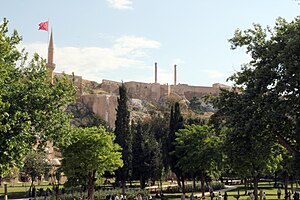Urfa Citadel
| Urfa Citadel | ||
|---|---|---|
|
Urfa Citadel from the northeast |
||
| Alternative name (s): | Urfa Kalesi | |
| Creation time : | first construction 3rd century AD | |
| Castle type : | Hilltop castle | |
| Conservation status: | ruin | |
| Construction: | Cuboid, boss cuboid | |
| Place: | Şanlıurfa | |
| Geographical location | 37 ° 8 '44 " N , 38 ° 47' 2" E | |
| Height: | 550 m | |
|
|
||
The citadel of Urfa ( Turkish Urfa Kalesi ) in the Turkish provincial capital Şanlıurfa is the ruin of a fortress from the time of the Crusaders , which was built on an older complex.
location
The fortress is located in the south of today's city of Şanlıurfa, whose former name was Urfa, in ancient times Edessa. It stands on a branch of the Top Dağı (also Nemrud Dağı), directly south of today's, later built, complex around the sacred pond Balıklıgöl with several mosques, the Gölbaşı Park and the bazaar in the east. The castle hill rises about 30 meters above the park.
history
The city of Edessa, the capital of the local Osrhoene kingdom , had a surrounding city wall as early as the 3rd century AD. After the lower-lying parts of the city were flooded by the Daisan river (ancient name Skirtos) , Abgar VIII built a winter palace in 201 on the southwest corner of the wall ring on the castle hill. The summer palace was located in the endangered area of today's ponds. The only remains of this building are the two approximately 15 meter high columns with Corinthian capitals that still tower over the ruins today. Popularly they are called the throne of Nimrod , who according to legend should have had a palace here. After renewed floods in 303, 413 and 525, the governor of the Roman emperor Justinian had the Skirtos diverted into a new river bed that ran past the city to the east and north. In the course of the subsequent reconstruction, parts of the castle were integrated into the city wall, and additional moats were dug around the castle wall in the south and west. Despite the strong fortifications, the city and castle changed hands several times in the following centuries between Persians , Byzantines and finally in 638 the Muslims. In 1031 the Byzantine general Georgios Maniakes was able to repurchase the Edessa fortress for the Byzantine Empire and had the fortification expanded. Attacks by Ibn Waṯṯāb of Harran (1036) and the Seljuk Alp Arslan (1071) could be repulsed. In 1083 the Kuropalates Philaretos Brachamios was able to conquer the city briefly. Thereafter, the Armenian Thoros came to power and also expanded the castle until he was murdered in 1098 during inner-city unrest and was replaced by the crusader Baudouin of Boulogne . Until the final conquest and destruction of the city by the Seljuks in 1147, the castle remained in the hands of the crusaders, who in turn expanded it. Restoration work has been carried out since 2007. On April 19, 2013, part of the fortification wall collapsed because heavy rain had washed away the ground. No one was injured in the incident.
description
The fortress measures about 300 meters in an east-west direction, and in a north-south direction it has an inner width of about 80 meters. Only the outer terrace walls and the two columns of the Syro-Roman palace are preserved today. On the mountain side in the south, the twelve-meter-deep moat has been preserved. There were probably gates on both the city and the land side, today's modern entrance in the north probably corresponds to the medieval main gate. The interior has been completely destroyed, and there are no traces of the mosque that has been documented. The Sultan of the Rum Seljuks Ala ad-Din Kai Kobad I had the Donjon of the Crusaders, of which the remains of the wall can still be seen south of the two pillars . The existing moat is certainly an extension of existing moats from the time of Justinian and Maniakes by the Crusaders. Possible shares of the Seljuks, Artukids and Mamluks in the building fabric are still unclear until a detailed investigation.
literature
- Hansgerd Hellenkemper : Crusader castles in the county of Edessa and in the Kingdom of Lesser Armenia. (= Geographica Historica 1 ) Habelt, Bonn 1976, ISBN 3-7749-1205-X , pp. 31-37
Web links
- Şanlıurfa Kale ve Surları ( Memento from March 9, 2013 in the Internet Archive ) (Turkish)
- Edesse - Forteresses d'Orient (French)
Individual evidence
- ↑ Şanlıurfa göçük meydana geldi - notification of the Turkish DHA from April 19, 2013

